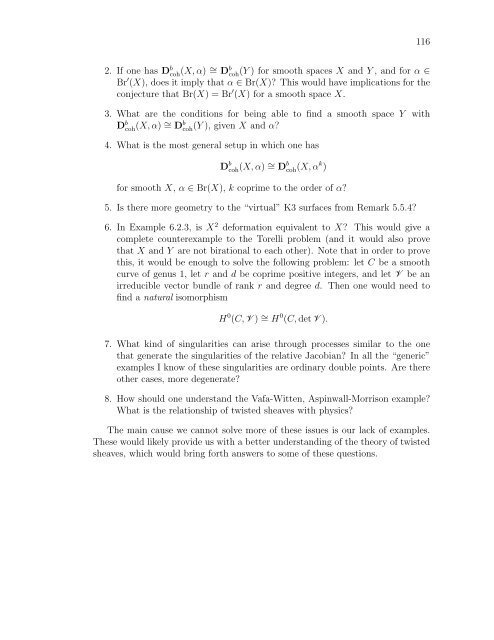derived categories of twisted sheaves on calabi-yau manifolds
derived categories of twisted sheaves on calabi-yau manifolds
derived categories of twisted sheaves on calabi-yau manifolds
Create successful ePaper yourself
Turn your PDF publications into a flip-book with our unique Google optimized e-Paper software.
116<br />
2. If <strong>on</strong>e has Db coh (X, α) ∼ = Db coh (Y ) for smooth spaces X and Y , and for α ∈<br />
Br ′ (X), does it imply that α ∈ Br(X)? This would have implicati<strong>on</strong>s for the<br />
c<strong>on</strong>jecture that Br(X) = Br ′ (X) for a smooth space X.<br />
3. What are the c<strong>on</strong>diti<strong>on</strong>s for being able to find a smooth space Y with<br />
Db coh (X, α) ∼ = Db coh (Y ), given X and α?<br />
4. What is the most general setup in which <strong>on</strong>e has<br />
D b coh(X, α) ∼ = D b coh(X, α k )<br />
for smooth X, α ∈ Br(X), k coprime to the order <str<strong>on</strong>g>of</str<strong>on</strong>g> α?<br />
5. Is there more geometry to the “virtual” K3 surfaces from Remark 5.5.4?<br />
6. In Example 6.2.3, is X 2 deformati<strong>on</strong> equivalent to X? This would give a<br />
complete counterexample to the Torelli problem (and it would also prove<br />
that X and Y are not birati<strong>on</strong>al to each other). Note that in order to prove<br />
this, it would be enough to solve the following problem: let C be a smooth<br />
curve <str<strong>on</strong>g>of</str<strong>on</strong>g> genus 1, let r and d be coprime positive integers, and let V be an<br />
irreducible vector bundle <str<strong>on</strong>g>of</str<strong>on</strong>g> rank r and degree d. Then <strong>on</strong>e would need to<br />
find a natural isomorphism<br />
H 0 (C, V ) ∼ = H 0 (C, det V ).<br />
7. What kind <str<strong>on</strong>g>of</str<strong>on</strong>g> singularities can arise through processes similar to the <strong>on</strong>e<br />
that generate the singularities <str<strong>on</strong>g>of</str<strong>on</strong>g> the relative Jacobian? In all the “generic”<br />
examples I know <str<strong>on</strong>g>of</str<strong>on</strong>g> these singularities are ordinary double points. Are there<br />
other cases, more degenerate?<br />
8. How should <strong>on</strong>e understand the Vafa-Witten, Aspinwall-Morris<strong>on</strong> example?<br />
What is the relati<strong>on</strong>ship <str<strong>on</strong>g>of</str<strong>on</strong>g> <str<strong>on</strong>g>twisted</str<strong>on</strong>g> <str<strong>on</strong>g>sheaves</str<strong>on</strong>g> with physics?<br />
The main cause we cannot solve more <str<strong>on</strong>g>of</str<strong>on</strong>g> these issues is our lack <str<strong>on</strong>g>of</str<strong>on</strong>g> examples.<br />
These would likely provide us with a better understanding <str<strong>on</strong>g>of</str<strong>on</strong>g> the theory <str<strong>on</strong>g>of</str<strong>on</strong>g> <str<strong>on</strong>g>twisted</str<strong>on</strong>g><br />
<str<strong>on</strong>g>sheaves</str<strong>on</strong>g>, which would bring forth answers to some <str<strong>on</strong>g>of</str<strong>on</strong>g> these questi<strong>on</strong>s.
















